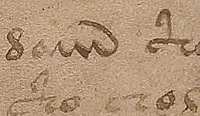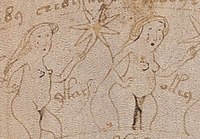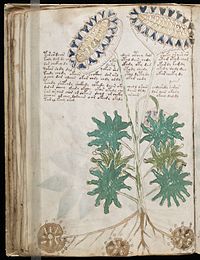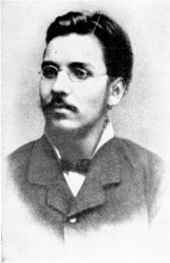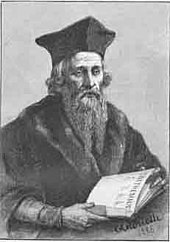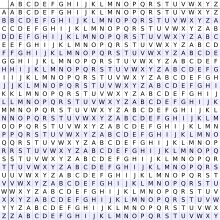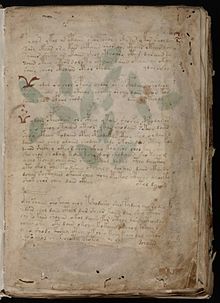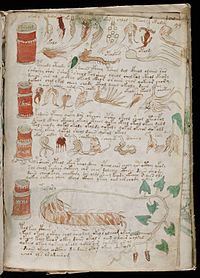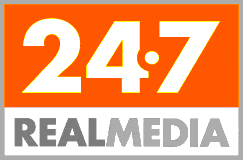Karin Marie Olt’s Book: Lisa and Leonardo’s Creations From the Voynich Manuscript Solved by Karin Marie Olt on Amazon!
Voynich manuscript
| Voynich manuscript | |
|---|---|
| Beinecke Rare Book and Manuscript Library, Yale University |
|

A floral illustration on page 32; the colors are still vibrant
|
|
| Also known as | Beinecke MS 408 |
| Type | codex |
| Date | early 15th century[1][2] 1404–1438[2] |
| Place of origin | possibly Northern Italy[1][2] |
| Language(s) | unknown possibly natural[3] or constructed language[4][5] very small number of words was found inLatin language[4][6] andHigh German language[6] |
| Scribe(s) | unknown |
| Author(s) | unknown suggested: Roger Bacon,[7] Wilfrid Voynich himself,[8] Jakub Sinapius of Tepenec,[9] Athanasius Kircher,[10] Raphael Mnishovsky,[7] Antonio Averlino Filarete,[11] Cornelis Drebbel,[12] Anthony Ascham[4] etc. |
| Compiled by | unknown |
| Illuminated by | unknown |
| Patron | unknown |
| Dedicated to | unknown |
| Material | vellum (type of the parchment from a tannedmammal skin) |
| Size | ≈ 23,5 cm × 16,2 cm × 5 cm |
| Format | one column in the page body, with slightly indented right margin and with paragraph divisions, and often with stars in the left margin;[13] the rest of the manuscript appears in the form of graphics i.e. diagrams or markings for certain parts related to illustrations; the manuscript contains foldable parts |
| Condition | partially damaged and incomplete; 240 out of 272 pages found (≈ 88%)[6][11][13] i.e. 18 out of 20 quires found (272 pages i.e. 20 quires is the smallest estimated number, and it contains > 170.000 characters)[14] |
| Script | unknown possibly it is an invented script[15] very small number of words found inLatin script[4][6] |
| Contents | herbal, astronomical, biological, cosmological and pharmaceutical sections + section with recipes |
| Illumination(s) | color ink, a bit crude, was used for painting the figures, probably later than the time of creation of the text and the outlines themselves[6] |
| Additions | – |
| Exemplar(s) | two manuscript copies which Baresch sent twice to Kircher in Rome |
| Previously kept | ? → Rudolf II, Holy Roman Emperor → Jakub of Tepenec → Georg Baresch → Athanasius Kircher (copies) → Jan Marek Marci (Joannes Marcus Marci) → rector of Charles University in Prague → Athanasius Kircher → Pieter Jan Beckx → Wilfrid Voynich → Ethel Voynich → Anne Nill → Hans Peter Kraus → Yale[4][10][13][16][17] |
| Discovered | earliest information about the existence comes from a letter that was found inside the covers of the manuscript, and it was written in either 1665 or 1666 |
| Accession | MS 408 |
| Other | famous cryptography case which has not been solved/deciphered to this day i.e. meaning of the content is still not discovered |
The Voynich manuscript is an illustrated codex hand-written in an unknown writing system. The vellum on which it is written has been carbon-dated to the early 15th century (1404–1438), and it may have been composed in Northern Italy during the Italian Renaissance.[1][2] The manuscript is named after Wilfrid Voynich, a Polish book dealer who purchased it in 1912.[18]
Some of the pages are missing, with around 240 remaining. The text is written from left to right, and most of the pages have illustrations or diagrams. Some pages are foldable sheets.
The Voynich manuscript has been studied by many professional and amateur cryptographers, including American and British codebreakers from both World War I and World War II.[19] No one has yet succeeded in deciphering the text, and it has become a famous case in the history of cryptography. The mystery of the meaning and origin of the manuscript has excited the popular imagination, making the manuscript the subject of novels and speculation. None of the many hypotheses proposed over the last hundred years has yet been independently verified.[20]
In 1969 the Voynich manuscript was donated by Hans P. Kraus[21] to Yale University‘s Beinecke Rare Book and Manuscript Library, where it is catalogued under call number MS 408.[13][22]
Contents
[hide]
Description[edit]
Codicology[edit]
The codicology, or physical characteristics of the manuscript, are studied by various researchers. The manuscript measures 23.5 by 16.2 by 5 centimetres (9.3 by 6.4 by 2.0 in), with hundreds of vellum pages collected into eighteen quires (units of 25 pages). The total number of pages is around 240, but the exact number depends on how the manuscript’s unusual foldouts are counted.[13] The quires have been numbered from 1 to 20 in various locations, using numerals consistent with the 1400s, and the top righthand corner of each recto (righthand) page has been numbered from 1 to 116, using numerals of a later date. From the various numbering gaps in the quires and pages, it seems likely that in the past the manuscript had at least 272 pages in 20 quires, some of which were already missing when Wilfrid Voynich acquired the manuscript in 1912. There is strong evidence that many of the book’s bifolios were reordered at various points in its history, and that the original page order may well have been quite different from what it is today.[6][11]
Parchment, covers, and binding[edit]
Protein testing in 2014 revealed that the parchment was made from calf skin, and multispectral analysis showed that it was unwritten on before the manuscript was created. The parchment was created with care, but deficiencies exist and the quality is assessed as average, at best.[23]
Some folios are thicker than the usual parchment thickness, such as bifolios 42 and 47.[24]
The goat skin[25] binding and covers are not original to the book but date to its possession by the Collegio Romano.[13] Insect holes are present on the first and last folios of the manuscript in the current order and suggest that a wooden cover was present before the later covers, and discolouring on the edges points to a tanned leather inside cover.[23]
Ink[edit]
Many pages contain substantial drawings or charts which are colored with paint. Based on modern analysis using polarized light microscopy (PLM), it has been determined that a quill pen and iron gall ink were used for the text and figure outlines; the colored paint was applied (somewhat crudely) to the figures, possibly at a later date. The ink of the drawings, text and page and quire numbers had similar microscopic characteristics. Energy-dispersive X-ray spectroscopy (EDS) performed in 2009 revealed that the inks contained major amounts of iron, sulfur, potassium, calcium and carbon and trace amounts of copper and occasionally zinc. EDS did not show the presence of lead, while X-ray Diffraction (XRD) identified potassium lead oxide, potassium hydrogen sulphate and syngenite in one of the samples tested. The similarity between the drawing inks and text inks suggested a contemporaneous origin.[6]
Paint[edit]
The blue, clear (or white), red-brown, and green paints of the manuscript have been analyzed using PLM, XRD, EDS, and scanning electron microscopy (SEM). The blue paint proved to be ground azurite with minor traces of the copper oxide cuprite. The clear paint is likely a mixture of eggwhite and calcium carbonate, while the green paint is tentatively characterized by copper and copper-chlorine resinate; the crystalline material might be atacamite or another copper-chlorine compound. Analysis of the red-brown paint indicated a red ochre with the crystal phases hematite and iron sulfide. Minor amounts of lead sulfide and palmierite were possibly present in the red-brown paint.[6] The pigments were considered inexpensive.[23]
Retouching[edit]
It is highlighted by computer scientist Jorge Stolfi of the University of Campinas that parts of the text and drawings are modified, using darker ink over a fainter earlier script. Evidence for this is visible in various folios, for example f1r, f3v, f26v, f57v, f67r2, f71r, f72v1, f72v3 and f73r.[26]
Text[edit]
Every page in the manuscript contains text, mostly in an unknown language, but some have extraneous writing in Latin script. The bulk of the text in the 240-page manuscript is written in an unknown script, running left to right. Most of the characters are composed of one or two simple pen strokes. There is some dispute as to whether certain characters are distinct, but a script of 20–25 characters would account for virtually all of the text; the exceptions are a few dozen rarer characters that occur only once or twice each. There is no obvious punctuation.[4]
Much of the text is written in a single column in the body of a page, with a slightly ragged right margin and paragraph divisions and sometimes with stars in the left margin.[13]Other text occurs in charts or as labels associated with illustrations. There are no indications of any errors or corrections made at any place in the document. The ductus flows smoothly, giving the impression that the symbols were not enciphered; there is no delay between characters, as would normally be expected in written encoded text.
The text consists of over 170,000 characters,[14] with spaces dividing the text into about 35,000 groups of varying length, usually referred to as “words” or “word tokens” (37,919). 8,114 of those words are considered unique “word types”.[27] The structure of these words seems to follow phonological or orthographic laws of some sort; for example, certain characters must appear in each word (like English vowels), some characters never follow others, some may be doubled or tripled but others may not, etc.[citation needed] The distribution of letters within words is also rather peculiar; some characters occur only at the beginning of a word, some only at the end, and some always in the middle section.[citation needed] Professor Gonzalo Rubio, expert in ancient languages at Pennsylvania State University, stated that “the things we know as ‘grammatical markers’ – things that occur commonly at the beginning or end of words, such as ‘s’ or ‘d’ in our language, and that are used to express grammar, never appear in the middle of ‘words’ in the Voynich manuscript. That’s unheard of for any Indo-European, Hungarian or Finnish language.”[28] Many researchers have commented upon the highly regular structure of the words.[29]
Some words occur in only certain sections, or in only a few pages; others occur throughout the manuscript. There are very few repetitions among the thousand or so labels attached to the illustrations. There are practically no words with fewer than two letters or more than ten.[14] There are instances where the same common word appears up to three times in a row.[14]Words that differ by only one letter also repeat with unusual frequency, causing single-substitution alphabet decipherings to yield babble-like text. In 1962, cryptanalyst Elizebeth Friedman described such attempts as “doomed to utter frustration”.[30]
Various transcription alphabets have been created to equate the Voynich characters with Latin characters in order to help with cryptanalysis, such as the European Voynich Alphabet. The first major one was created by cryptographer William F. Friedman in the 1940s, where each line of the manuscript was transcribed to an IBM punch card to make it machine readable.[31]
Extraneous writing[edit]
Only a few words in the manuscript are considered to be not written in the unknown script:[17]
- f1r: A sequence of Latin letters in the right margin parallel with characters from the unknown script. There is also the now unreadable signature of “Jacobj à Tepenece” in the bottom margin.
- f17r: A line of writing in the Latin script in the top margin.
- f70v–f73v: The astrological series of diagrams in the astronomical section has the names of ten of the months (from March to December) written in Latin script, with spelling suggestive of the medieval languages of France, northwest Italy, or the Iberian Peninsula.[32]
- f66r: A small number of words in the bottom left corner near a drawing of a nude man. They have been read as “der musz del”, a High German[17] word for a widow’s share.
- f116v: Four lines written in rather distorted Latin script, except for two words in the unknown script. The words in Latin script appear to be distorted with characteristics of the unknown language. The lettering resembles European alphabets of the late 14th and 15th centuries, but the words do not seem to make sense in any language.[33]
It is not known whether these bits of Latin script were part of the original text or were added later.
Illustrations[edit]
The illustrations are conventionally used to divide most of the manuscript into six different sections, since the text itself cannot be read. Each section is typified by illustrations with different styles and supposed subject matter[14] except for the last section, in which the only drawings are small stars in the margin. The following are the sections and their conventional names:
- Herbal, 112 folios: Each page displays one or two plants and a few paragraphs of text, a format typical of European herbals of the time. Some parts of these drawings are larger and cleaner copies of sketches seen in the “pharmaceutical” section. None of the plants depicted are unambiguously identifiable.[13][34]
- Astronomical, 21 folios: Contains circular diagrams suggestive of astronomy or astrology, some of them with suns, moons, and stars. One series of 12 diagrams depicts conventional symbols for the zodiacal constellations (two fish for Pisces, a bull for Taurus, a hunter with crossbow for Sagittarius, etc.). Each of these has 30 female figures arranged in two or more concentric bands. Most of the females are at least partly nude, and each holds what appears to be a labeled star or is shown with the star attached to either arm by what could be a tether or cord of some kind. The last two pages of this section were lost (Aquarius and Capricornus, roughly January and February), while Aries and Taurus are split into four paired diagrams with 15 women and 15 stars each. Some of these diagrams are on fold-out pages.[13][34]
- Biological, 20 folios: A dense continuous text interspersed with figures, mostly showing small nude women, some wearing crowns, bathing in pools or tubs connected by an elaborate network of pipes. The bifolio consists of folios 78 (verso) and 81 (recto); it forms an integrated design, with water flowing from one folio to the other.[23][34]
- Cosmological, 13 folios: More circular diagrams but of an obscure nature. This section also has foldouts; one of them spans six pages, commonly called the Rosettes folio, and contains a map or diagram with nine “islands” or “rosettes” connected by “causeways” and containing castles, as well as what might be a volcano.[13][34][35]
- Pharmaceutical, 34 folios: Many labeled drawings of isolated plant parts (roots, leaves, etc.), objects resembling apothecary jars, ranging in style from the mundane to the fantastical, and a few text paragraphs.[13][34]
- Recipes, 22 folios: Full pages of text broken into many short paragraphs, each marked with a star in the left margin.[13][34]
Five folios contain only text, and at least 28 folios are missing from the manuscript.[34]
Purpose[edit]
The overall impression given by the surviving leaves of the manuscript is that it was meant to serve as a pharmacopoeia or to address topics in medieval or early modern medicine. However, the puzzling details of illustrations have fueled many theories about the book’s origin, the contents of its text, and the purpose for which it was intended.[14]
The first section of the book is almost certainly herbal, but attempts have failed to identify the plants, either with actual specimens or with the stylized drawings of contemporaneous herbals.[36] Only a few of the plant drawings can be identified with reasonable certainty, such as a wild pansy and the maidenhair fern. The herbal pictures that match pharmacological sketches appear to be clean copies of them, except that missing parts were completed with improbable-looking details. In fact, many of the plant drawings in the herbal section seem to be composite: the roots of one species have been fastened to the leaves of another, with flowers from a third.[36]
Botanist Hugh O’Neill believed that one illustration depicted a New World sunflower, which would help date the manuscript and open up intriguing possibilities for its origin; unfortunately, the identification is only speculative.[14]
The basins and tubes in the “biological” section are sometimes interpreted as implying a connection to alchemy, yet they bear little obvious resemblance to the alchemical equipment of the period.[citation needed]
Astrological considerations frequently played a prominent role in herb gathering, bloodletting, and other medical procedures common during the likeliest dates of the manuscript. However, interpretation remains speculative, apart from the obvious Zodiac symbols and one diagram possibly showing the classical planets.[14]
The full manuscript[edit]
Below is the full manuscript in a table that can be sorted according to pages, folio numbers, topics or images. Missing pages are indicated.
| Page | Folio | Topic | Image | Image | Topic | Folio | [show]Page | ||||
|---|---|---|---|---|---|---|---|---|---|---|---|
History[edit]
Joannes Marcus Marci (1595–1667), who sent the manuscript to Athanasius Kircher in 1665 or 1666
Much of the early history of the book is unknown,[37] though the text and illustrations are all characteristically European. In 2009, University of Arizona researchers performed radiocarbon dating on the manuscript’s vellum and dated it between 1404 and 1438.[2][38][39] In addition, the McCrone Research Institute in Chicago found that the paints in the manuscript were of materials to be expected from that period of European history. It has been suggested that the McCrone Research Institute found that much of the ink was added not long after the creation of the parchment, but the official report contains no statement to this effect.[6]
The first confirmed owner was Georg Baresch (1585–1662), an obscure alchemist from Prague. Baresch was apparently just as puzzled as modern scientists about this “Sphynx” that had been “taking up space uselessly in his library” for many years.[10] He learned that Jesuit scholar Athanasius Kircher (1602–1680) from the Collegio Romano had published a Coptic (Egyptian) dictionary and claimed to have deciphered the Egyptian hieroglyphs; Baresch twice sent a sample copy of the script to Kircher in Rome, asking for clues. His 1639 letter to Kircher is the earliest confirmed mention of the manuscript that has been found to date.[16]
It is not known whether Kircher answered the request, but he was apparently interested enough to try to acquire the book, which Baresch refused to yield. Upon Baresch’s death, the manuscript passed to his friend Jan Marek Marci (1595–1667; also known as Johannes Marcus Marci), then rector of Charles University in Prague. A few years later, Marci sent the book to Kircher, his longtime friend and correspondent.[16]
A letter written on August 19, 1665[10][40][41] or 1666[41][42][43] was found inside the cover and accompanied the manuscript when Johannes Marcus sent it to Kircher. It claims that the book once belonged to Emperor Rudolf II (1552–1612), who paid 600 gold ducats (about 2.07 kg of gold) for it. The letter was written in Latin[44] and has been translated to English.[40][45] The book was then given or lent to Jacobus Horcicky de Tepenecz (died 1622), the head of Rudolf’s botanical gardens in Prague, probably as part of the debt that Rudolf II owed upon his death.[37]
Marci’s 1665/6 cover letter written in Latin was still with the manuscript when Voynich purchased it:[4]
Reverend and Distinguished Sir, Father in Christ:
This book, bequeathed to me by an intimate friend, I destined for you, my very dear Athanasius, as soon as it came into my possession, for I was convinced that it could be read by no one except yourself.
The former owner of this book asked your opinion by letter, copying and sending you a portion of the book from which he believed you would be able to read the remainder, but he at that time refused to send the book itself. To its deciphering he devoted unflagging toil, as is apparent from attempts of his which I send you herewith, and he relinquished hope only with his life. But his toil was in vain, for such Sphinxes as these obey no one but their master, Kircher. Accept now this token, such as it is and long overdue though it be, of my affection for you, and burst through its bars, if there are any, with your wonted success.
Dr. Raphael, a tutor in the Bohemian language to Ferdinand III, then King of Bohemia, told me the said book belonged to the Emperor Rudolph and that he presented to the bearer who brought him the book 600 ducats. He believed the author was Roger Bacon, the Englishman. On this point I suspend judgement; it is your place to define for us what view we should take thereon, to whose favor and kindness I unreservedly commit myself and remain
Wilfrid Voynich (1865–1930) acquired the manuscript in 1912
There are no records of the book for the next 200 years but, in all likelihood, it was probably stored with the rest of Kircher’s correspondence in the library of the Collegio Romano (now the Pontifical Gregorian University).[16] It probably remained there until the troops of Victor Emmanuel II of Italy captured the city in 1870 and annexed the Papal States. The new Italian government decided to confiscate many properties of the Church, including the library of the Collegio.[16] Many books of the university’s library were hastily transferred to the personal libraries of its faculty just before this happened, according to investigations by Xavier Ceccaldi and others, and those books were exempt from confiscation.[16] Kircher’s correspondence was among those books, and so, apparently, was the Voynich manuscript, as it still bears the ex libris of Petrus Beckx, head of the Jesuit order and the university’s rector at the time.[13][16]
Beckx’s private library was moved to the Villa Mondragone, Frascati, a large country palace near Rome that had been bought by the Society of Jesus in 1866 and housed the headquarters of the Jesuits’ Ghislieri College.[16]
Around 1912, the Collegio Romano was short of money and decided to sell some of its holdings discreetly. Wilfrid Voynich acquired 30 manuscripts, among them the one which now bears his name.[16] He spent the next seven years attempting to interest scholars in deciphering the script, while he worked to determine the origins of the manuscript.[4]
In 1930, the manuscript was inherited after Wilfrid’s death by his widow Ethel Voynich, author of the novel The Gadfly and daughter of mathematician George Boole. She died in 1960 and left the manuscript to her close friend Anne Nill. In 1961, Nill sold the book to antique book dealer Hans P. Kraus. Kraus was unable to find a buyer and donated the manuscript to Yale University in 1969, where it was catalogued as “MS 408,”[17] sometimes also referred to as “Beinecke MS 408.”[13]
Timeline of ownership[edit]
The timeline of ownership of the Voynich manuscript is given below. The commonly accepted owners of the 17th century are shown in orange; the long period of storage in the Collegio Romano is shown in yellow; the location where Wilfrid Voynich allegedly acquired the manuscript (Frascati) is shown in green; Voynich is shown in red; and modern owners are shown in blue. Periods of unknown ownership are indicated in white, and the time when it was possibly created in green, based on the carbon dating of the vellum.[37]
| [show]Timeline of Voynich manuscript ownership |
Authorship hypotheses[edit]
Many people have been proposed as possible authors of the Voynich manuscript.
Edward Kelley (1555–97) might have created the manuscript as a fraud
Marci’s 1665/6 cover letter to Kircher says that, according to his friend the late Raphael Mnishovsky, the book had once been bought by Rudolf II, Holy Roman Emperor and King of Bohemia (1552–1612) for 600 ducats (66.42 troy ounce actual gold weight, or 2.07 kg). (Mnishovsky had died in 1644, more than 20 years earlier, and the deal must have occurred before Rudolf’s abdication in 1611, at least 55 years before Marci’s letter.) According to the letter, Mnishovsky (but not necessarily Rudolf) speculated that the author was Franciscan friar and polymath Roger Bacon (1214–94).[7] Marci said that he was suspending judgment about this claim, but it was taken quite seriously by Wilfrid Voynich who did his best to confirm it.[16] Voynich contemplated the possibility that the author was Albertus Magnus if not Roger Bacon.[46]
Mathematician John Dee (1527–1608) may have sold the manuscript to Emperor Rudolf around 1600.
The assumption that Bacon was the author led Voynich to conclude that John Dee (1527–1608) sold the manuscript to Rudolf. Dee was a mathematician and astrologer at the court of Queen Elizabeth I of England who was known to have owned a large collection of Bacon’s manuscripts. Dee and his scrier (spirit medium) Edward Kelley lived in Bohemia for several years, where they had hoped to sell their services to the emperor. However, this sale seems quite unlikely, according to John Schuster, because Dee’s meticulously kept diaries do not mention it.[16] If Bacon did not create the Voynich manuscript, a supposed connection to Dee is much weakened. It was thought possible, prior to the carbon dating of the manuscript, that Dee or Kelley might have written it and spread the rumor that it was originally a work of Bacon’s in the hopes of later selling it.[47]
Fabrication by Voynich[edit]
Some suspect Voynich of having fabricated the manuscript himself.[8] As an antique book dealer, he probably had the necessary knowledge and means, and a lost book by Roger Bacon would have been worth a fortune. Furthermore, Baresch’s letter and Marci’s letter only establish the existence of a manuscript, not that the Voynich manuscript is the same one spoken of. These letters could possibly have been the motivation for Voynich to fabricate the manuscript, assuming that he was aware of them. However, many consider the expert internal dating of the manuscript and the June 1999[37] discovery of Baresch’s letter to Kircher as having eliminated this possibility.[8][16]
Other theories[edit]
Sometime before 1921, Voynich was able to read a name faintly written at the foot of the manuscript’s first page: “Jacobj à Tepenece”. This is taken to be a reference to Jakub Hořčický of Tepenec (1575–1622), also known by his Latin name Jacobus Sinapius. Rudolph II had ennobled him in 1607, had appointed him his Imperial Distiller, and had made him curator of his botanical gardens as well as one of his personal physicians. Voynich (and many other people after him) concluded that Jacobus owned the Voynich manuscript prior to Baresch, and he drew a link from that to Rudolf’s court, in confirmation of Mnishovsky’s story.
Jacobus’s name is still clearly visible under ultraviolet light; however, it does not match the copy of his signature in a document located by Jan Hurych in 2003.[1][9] As a result, it has been suggested that the signature was added later, possibly even fraudulently by Voynich himself.[1]
It has been noted that Baresch’s letter bears some resemblance to a hoax that orientalist Andreas Mueller once played on Kircher. Mueller sent some unintelligible text to Kircher with a note explaining that it had come from Egypt, and asking him for a translation. Kircher reportedly solved it.[48] It has been speculated that these were both cryptographic tricks played on Kircher to make him look foolish.[48]
Raphael Mnishovsky, the friend of Marci who was the reputed source of Bacon’s story, was himself a cryptographer and apparently invented a cipher which he claimed was uncrackable (ca. 1618).[49] This has led to the speculation that Mnishovsky might have produced the Voynich manuscript as a practical demonstration of his cipher and made Baresch his unwitting test subject. Indeed, the disclaimer in the Voynich manuscript cover letter could mean that Marci suspected some kind of deception.[49]
In his 2006 book, Nick Pelling proposed that the Voynich manuscript was written by 15th century North Italian architect Antonio Averlino (also known as “Filarete”), a theory broadly consistent with the radiocarbon dating.[11]
H. Richard SantaColoma has speculated that the Voynich Manuscript may be connected to 17th century Dutch inventor Cornelis Drebbel, initially suggesting that it was Drebbel’s cipher notebook on microscopy and alchemy, and then later hypothesising that it is a fictional tie-in to Francis Bacon‘s utopian novel New Atlantis, in which some of Drebbel’s inventions and ideas are said to appear (e.g., submarine, perpetual clock).[12]
Language hypotheses[edit]
There are many hypotheses about the Voynich manuscript’s “language”, called Voynichese:
|
|
This section possibly contains original research. (January 2017) (Learn how and when to remove this template message) |
Ciphers[edit]
The Voynich manuscript is written in an unknown script
According to the “letter-based cipher” theory, the Voynich manuscript contains a meaningful text in some European language that was intentionally rendered obscure by mapping it to the Voynich manuscript “alphabet” through a cipher of some sort—an algorithm that operated on individual letters. This has been the working hypothesis for most twentieth-century deciphering attempts, including an informal team of NSAcryptographers led by William F. Friedman in the early 1950s.[31]
The main argument for this theory is that it is difficult to explain a European author using a strange alphabet—except as an attempt to hide information. Indeed, even Roger Bacon knew about ciphers, and the estimated date for the manuscript roughly coincides with the birth of cryptography in Europe as a relatively systematic discipline.[50][unreliable source?]
The counterargument is that almost all cipher systems consistent with that era fail to match what is seen in the Voynich manuscript. For example, simple substitution ciphers would be excluded because the distribution of letter frequencies does not resemble that of any known language; while the small number of different letter shapes used implies that nomenclator and homophonic ciphers would be ruled out, because these typically employ larger cipher alphabets. Polyalphabetic ciphers were invented by Alberti in the 1460s and included the later Vigenère cipher, but they usually yield ciphertexts where all cipher shapes occur with roughly equal probability, quite unlike the language-like letter distribution which the Voynich Manuscript appears to have.[50]
However, the presence of many tightly grouped shapes in the Voynich manuscript (such as “or”, “ar”, “ol”, “al”, “an”, “ain”, “aiin”, “air”, “aiir”, “am”, “ee”, “eee”, among others) does suggest that its cipher system may make use of a “verbose cipher”, where single letters in a plaintext get enciphered into groups of fake letters. For example, the first two lines of page f15v (seen above) contain “oror or” and “or or oro r”, which strongly resemble how Roman numbers such as “CCC” or “XXXX” would look if verbosely enciphered.[51]
It is also entirely possible that the encryption system started from a fundamentally simple cipher and then augmented it by adding nulls (meaningless symbols), homophones (duplicate symbols), transposition cipher (letter rearrangement), false word breaks, and more.[50]
Codes[edit]
According to the “codebook cipher” theory, the Voynich manuscript “words” would actually be codes to be looked up in a “dictionary” or codebook. The main evidence for this theory is that the internal structure and length distribution of many words are similar to those of Roman numerals, which at the time would be a natural choice for the codes. However, book-based ciphers would be viable for only short messages, because they are very cumbersome to write and to read.[50]
Steganography[edit]
This theory holds that the text of the Voynich manuscript is mostly meaningless, but contains meaningful information hidden in inconspicuous details—e.g., the second letter of every word, or the number of letters in each line. This technique, called steganography, is very old and was described by Johannes Trithemius in 1499. Though it has been speculated that the plain text was to be extracted by a Cardan grille (an overlay with cut-outs for the meaningful text) of some sort, this seems somewhat unlikely because the words and letters are not arranged on anything like a regular grid. Still, steganographic claims are hard to prove or disprove, since stegotexts can be arbitrarily hard to find.
It has been suggested that the meaningful text could be encoded in the length or shape of certain pen strokes.[52][53] There are indeed examples of steganography from about that time that use letter shape (italic vs. upright) to hide information. However, when examined at high magnification, the Voynich manuscript pen strokes seem quite natural, and substantially affected by the uneven surface of the vellum.[50]
Natural language[edit]
Statistical analysis of the text reveals patterns similar to those of natural languages. For instance, the word entropy (about 10 bits per word) is similar to that of English or Latin texts.[3] In 2013, Diego Amancio et al argued that the Voynich manuscript “is mostly compatible with natural languages and incompatible with random texts”.[54]
The linguist Jacques Guy once suggested that the Voynich manuscript text could be some little-known natural language, written in the plain with an invented alphabet. The word structure is similar to that of many language families of East and Central Asia, mainly Sino-Tibetan (Chinese, Tibetan, and Burmese), Austroasiatic (Vietnamese, Khmer, etc.) and possibly Tai (Thai, Lao, etc.). In many of these languages, the words have only one syllable; and syllables have a rather rich structure, including tonal patterns.[50]
This theory has some historical plausibility. While those languages generally had native scripts, these were notoriously difficult for Western visitors. This difficulty motivated the invention of several phonetic scripts, mostly with Latin letters but sometimes with invented alphabets. Although the known examples are much later than the Voynich manuscript, history records hundreds of explorers and missionaries who could have done it—even before Marco Polo‘s thirteenth century journey, but especially after Vasco da Gama sailed the sea route to the Orient in 1499.[50]
The main argument for this theory is that it is consistent with all statistical properties of the Voynich manuscript text which have been tested so far, including doubled and tripled words (which have been found to occur in Chinese and Vietnamese texts at roughly the same frequency as in the Voynich manuscript). It also explains the apparent lack of numerals and Western syntactic features (such as articles and copulas), and the general inscrutability of the illustrations. Another possible hint is two large red symbols on the first page, which have been compared to a Chinese-style book title, inverted and badly copied. Also, the apparent division of the year into 360 days (rather than 365 days), in groups of 15 and starting with Pisces, are features of the Chinese agricultural calendar (jie qi, 節氣). The main argument against the theory is the fact that no one (including scholars at the Chinese Academy of Sciences in Beijing) has been able to find any clear examples of Asian symbolism or Asian science in the illustrations.[50]
In 1976, James R Child of the National Security Agency, a linguist of Indo-European languages, proposed that the manuscript was written in a “hitherto unknown North Germanic dialect”.[55] He identified in the manuscript a “skeletal syntax several elements of which are reminiscent of certain Germanic languages”, while the content itself is expressed using “a great deal of obscurity”.[56]
In late 2003, Zbigniew Banasik of Poland proposed that the manuscript is plaintext written in the Manchu language and gave a proposed piecemeal translation of the first page of the manuscript.[57][unreliable source?]
In February 2014, Professor Stephen Bax of the University of Bedfordshire made public his research into using “bottom up” methodology to understand the manuscript. His method involves looking for and translating proper nouns, in association with relevant illustrations, in the context of other languages of the same time period. A paper he posted online offers tentative translation of 14 characters and 10 words.[58][59][60][61] He suggests the text is a treatise on nature written in a natural language, rather than a code.
In 2014, Arthur O. Tucker and Rexford H. Talbert published a paper claiming a positive identification of 37 plants, 6 animals, and 1 mineral referenced in the manuscript to plant drawings in the Libellus de Medicinalibus Indorum Herbis or Badianus manuscript, a fifteenth century Aztec herbal.[62] Together with the presence of atacamite in the paint, they argue that the plants were from Colonial New Spain and represented the Nahuatl language, and date the manuscript to between 1521 (the date of the Conquest) and c. 1576, in contradiction of radiocarbon dating evidence of the vellum and many other elements of the manuscript. The analysis has been criticized by other Voynich Manuscript researchers,[63] pointing out that—among other things—a skilled forger could construct plants that have a passing resemblance to theretofore undiscovered existing plants.[64]
Constructed language[edit]
The peculiar internal structure of Voynich manuscript words led William F. Friedman to conjecture that the text could be a constructed language. In 1950, Friedman asked the British army officer John Tiltman to analyze a few pages of the text, but Tiltman did not share this conclusion. In a paper in 1967, Brigadier Tiltman said:
After reading my report, Mr. Friedman disclosed to me his belief that the basis of the script was a very primitive form of synthetic universal language such as was developed in the form of a philosophical classification of ideas by Bishop Wilkins in 1667 and Dalgarno a little later. It was clear that the productions of these two men were much too systematic, and anything of the kind would have been almost instantly recognisable. My analysis seemed to me to reveal a cumbersome mixture of different kinds of substitution.[4]
The concept of an artificial language is quite old, as attested by John Wilkins‘s Philosophical Language (1668), but still postdates the generally accepted origin of the Voynich manuscript by two centuries. In most known examples, categories are subdivided by adding suffixes; as a consequence, a text in a particular subject would have many words with similar prefixes—for example, all plant names would begin with similar letters, and likewise for all diseases, etc. This feature could then explain the repetitious nature of the Voynich text. However, no one has been able yet to assign a plausible meaning to any prefix or suffix in the Voynich manuscript.[5]
Hoax[edit]
Page 135; f75r, from the biological section showing “nymphs”
The bizarre features of the Voynich manuscript text (such as the doubled and tripled words), and the suspicious contents of its illustrations support the idea that the manuscript is a hoax. In other words, if no one is able to extract meaning from the book, then perhaps this is because the document contains no meaningful content in the first place. Various hoax theories have been proposed over time.
In 2003, computer scientist Gordon Rugg showed that text with characteristics similar to the Voynich manuscript could have been produced using a table of word prefixes, stems, and suffixes, which would have been selected and combined by means of a perforated paper overlay.[65][66] The latter device, known as a Cardan grille, was invented around 1550 as an encryption tool, more than 100 years after the estimated creation date of the Voynich manuscript. Some maintain that the similarity between the pseudo-texts generated in Gordon Rugg’s experiments and the Voynich manuscript is superficial, and the grille method could be used to emulate any language to a certain degree.[67]
In April 2007, a study by Austrian researcher Andreas Schinner published in Cryptologia supported the hoax hypothesis.[68] Schinner showed that the statistical properties of the manuscript’s text were more consistent with meaningless gibberish produced using a quasi-stochastic method such as the one described by Rugg, than with Latin and medieval German texts.[68]
By September 2016, Gordon Rugg and Gavin Taylor published another article in Cryptologia, also supporting the hoax hypothesis[69] based on a hypothesis regarding the syllable and word distribution in the Voynich manuscript compared to that of different natural languages.
The argument for authenticity is that the manuscript appears too sophisticated to be a hoax. While hoaxes of the period tended to be quite crude, the Voynich manuscript exhibits many subtle characteristics which show up only after careful statistical analysis. The question then arises as to why the author would employ such a complex and laborious forging algorithm in the creation of a simple hoax, if no one in the expected audience (that is, the creator’s contemporaries) could tell the difference. Marcelo Montemurro, a theoretical physicist from the University of Manchester who spent years analysing the linguistic patterns in the Voynich manuscript, found semantic networks such as content-bearing words occurring in a clustered pattern, and new words being used when there was a shift in topic.[70] With this evidence, he believes it unlikely that these features were simply “incorporated” into the text to make a hoax more realistic, as most of the required academic knowledge of these structures did not exist at the time the Voynich manuscript would have been written. These fine touches require much more work than would have been necessary for a simple forgery, and some of the complexities are only visible with modern tools.[71]

